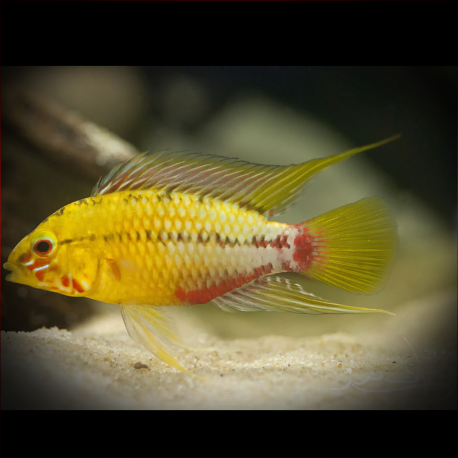More info
Datasheet
| Minimum Tank Size | 40 litres / 10.57 US gallons |
| Maximum Size | 6.0cm / 2.36inches |
| Temperature | 23°C / 73.40°F - 29°C / 84.20°F |
| Hardness | 1.01dgH / 18ppm - 15.02dgH / 268ppm |
| pH | 5.5-7.0 |
General Description
The Apistogramma Hongsloi, classified under the family Cichlidae and order Perciformes, is a species often assigned the code A110 in the DATZ ‘A-number’ system. This species is part of the diverse genus Apistogramma, known for being one of the most speciose South American cichlid genera, with approximately 70 validated species. The genus includes various geographical color forms, leading to potential hybridization risks in captivity, prompting hobbyists to label them with collection data. Apistogramma Hongsloi is typically a small fish, with males being larger, more colorful, and boasting extended fins compared to females.
Aquarium Setup
For an aquarium to house Apistogramma Hongsloi, a minimum tank size of 40 liters is recommended. The setup should include ample cover and structure, such as ceramic flowerpots, plastic piping, and wood roots. Artificial or natural décor, like sandy substrate, branches, and dried leaf litter (e.g., beech, oak, or Ketapang almond leaves), can provide shady spots and caves. The use of aquarium-safe peat in the filter or suspended over the tank edge is beneficial. Dim lighting is preferred, along with plant species like Microsorum, Taxiphyllum, Cryptocoryne, and Anubias. Filtration should be gentle, and water changes kept at 10-15% weekly if the tank is lightly stocked.
Behaviour
In captivity, it is advisable to choose captive-raised Apistogramma Hongsloi for community aquariums. Wild-caught specimens are best kept alone or with small 'dither' fish such as Nannostomus or Micropoecilia spp., as they may exhibit aggression. When mixed with other Apistogramma species, conflicts can arise. Female Apistogramma Hongsloi are responsible for post-spawning care of eggs and fry. In smaller tanks, it might be necessary to remove the male as the female can become hyper-aggressive.
Feeding and Diet
Apistogramma Hongsloi is primarily carnivorous, feeding on benthic invertebrates in its natural habitat. In captivity, they should be offered live and frozen foods like Artemia, Daphnia, and chironomid larvae. While they can learn to accept dried foods, pelleted products are generally preferred over flakes. Maintaining a varied diet is essential for their health and vitality.
Reproduction & Dimorphism
These fish are substrate spawners, with females laying eggs in crevices or cavities within the aquarium. Males are instrumental in the breeding process, displaying courtship behaviors and defending territories. Distinguishing between the sexes is relatively easy, as males are larger, more colorful, and exhibit extended fins compared to females.
Habitat and Distribution
Apistogramma Hongsloi is native to small tributaries and still waters in the Río Vichada and middle Río Meta basins in Colombia, as well as the middle section of the Orinoco system in Venezuela. They thrive in these freshwater environments and are adapted to the specific conditions found in these regions.

